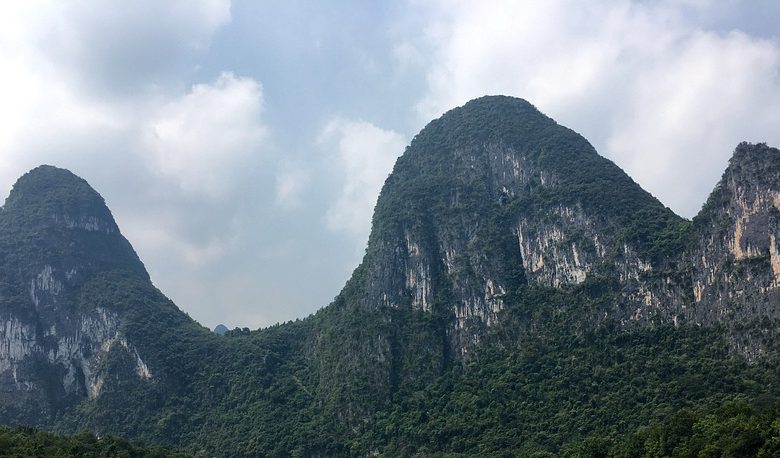Connexion: Bring life back to the shorn hills of Kinta Valley


By Joachim Ng
A nature-loving Australian couple, Jerry and Lorraine Schokman, visited Klang Valley two months ago and decided to spend half a day in Ipoh after hearing so much about the city. But as the car they were travelling in neared Tambun, the view on both sides of the North-South Expressway disturbed them. Upon returning to Selangor they lamented: “It is sad to see the destruction of nature.”
What brought down their spirits? They saw bare limestone hills shorn of trees with the topsoil removed and the rocks blasted off. This is sending a wrong message that the people of Ipoh have no concern for environmental restoration.
Some thought should be given to the feasibility of restoring a hill once the quarrying is over. It is just a matter of filling in the excavated areas, reshaping the landscape, and planting trees to mitigate the environmental impact of the quarrying operation.
There are, of course, several important steps that include the need to:
(i) Re-grade the slopes to reduce steepness;
(ii) Use erosion-control sheets to stabilise new soil that is put in;
(iii) Enrich the soil with organic matter and nutrients;
(iv) Plant trees, grasses, and wildflowers sourced from the area as these will not be invasive;
(v) Install a suitable irrigation system to maintain the vegetation during the early stages of restoration;
(vi) Create educational signage to raise awareness of the restoration project and its importance to the environment.
The Forest Research Institute of Malaysia (FRIM) has shown that bare land can be rehabilitated. Twelve years ago, it initiated a reforestation project on 20 hectares of former tin mining land in Gerik, Hulu Perak. It involved the planting of Acacia, Imerawan, Meranti, and Merawan, among other species.
Restoration is not a trivial need as Ipoh’s temperature has risen by 6.75 degrees C since 1998, the highest rise for any city in Malaysia. The main reason for the steep climb is the continuous expansion of road networks, housing estates, and commercial areas creating a heat island effect. With fewer trees, there is less cooling.
Furthermore, urbanisation has moved people away from nature with housing estates more than 5km from the nearest tree park. We’re not talking about children’s playgrounds with their flat surface and handful of scraggy trees. Ipoh residents seldom visit tree parks because nobody can walk 5km in the heat. And if it is not sunny, it pours.
Scientific studies in America have found that city residents whose homes are less than 5km distance from a tree park age slower and stay healthier. Exposure to natural environments reduces stress and lowers blood pressure while encouraging relaxation, socialisation with neighbours, and physical activity such as walking or jogging.
Singapore has done well in that no resident need walk more than a few hundred metres to reach a tree park, as there is one to serve every cluster of HDB flats. This is part of the reason why Singaporeans enjoy an average life expectancy of 86 years, compared with the Malaysian average life expectancy of 76 years only. It is not because Singaporeans are richer, as HDB residents are just earning middle-class incomes.
In the absence of a tree park within walking distance of your home, cultivate your own lush garden if you live in a landed property instead of cementing the outdoor compound totally. If you live in a condominium without a balcony, you can keep potted ferns or money plants in your living room.
Ferns and money plants are popular as they offer several benefits such as:
- Air purification: They improve indoor air quality by absorbing pollutants while releasing oxygen, hence acting as natural air purifiers.
- Stress reduction: Having plants can instil a sense of peace and reduce stress.
- Noise reduction: While not as effective as larger plants, ferns and money plants can help absorb some noise, making your living room feel quieter.
- Low maintenance: Ferns and money plants are very easy to care for and they only need a bit of sunlight. Their water requirements are also moderate.
- Connection to nature: Bringing natural greenery into your living room creates a sense of connection to nature, even if you live up in the sky.
If you are the boss in your office, utilise some of the interior walls for vertical gardening. First, assess the structural integrity of the chosen walls to ensure they can support the weight of the plants and the irrigation system. Next, choose plants taking into account factors such as light levels, humidity, and maintenance requirements. Low-maintenance plants like pothos, snake plants, and ferns are popular.
Should the directors ask why you are spending money doing green walls, tell them of the three key benefits:
- Creativity booster: Studies suggest that the presence of plants can boost creativity among office workers, reduce stress, improve wellbeing, and promote a friendly atmosphere for employees.
- Air quality: Plants naturally filter the air, removing toxins and pollutants which can contribute to better indoor air quality and fewer sick leave days.It also provides cooling effects which reduces the need for excessively low aircon temperature.
- Noise reduction: Plants can help absorb and muffle sound, making the office environment quieter and more conducive to concentration. In addition, green walls enhance the aesthetics, creating a more visually pleasing and inviting atmosphere for customers.
Another reason to go green at every opportunity is that it serves to remind us of the need to keep the number of trees in any area constant or even to increase it. On the shores of the biblical Euphrates River in Syria, there was once a majestic forest. Now it is mostly barren land as the trees have been chopped down for timber or to serve as cooking fire. There is no shade left, only the heat of the sun, and dust storms never stop.
Deforestation releases stored carbon back into the atmosphere as CO2, contributing to the buildup of greenhouse gases that enhance global warming and climate change.
Although 47% of Perak state has been gazetted as forest reserves under the National Forestry Act, the percentage is well below the 54% forest cover over the whole of Malaysia recorded in 2021 and 87% in 2010. On a global scale, the world lost 10 million acres of primary rainforest last year.
With continuing population expansion, we can never revert to 87% but we should strive to hit at least 50% in every state. Six months ago, the Association for Welfare Community and Dialogue commented that the slogan to make Ipoh a green city would be redundant if there was no collaborative effort to prevent the impact of climate change.
More seriously, environmental group RimbaWatch warned last March that the nation’s forest cover could drop to 47% of the total land area because of potential future deforestation affecting 2.3 million hectares.
As forests are cleared, the capacity of the land to absorb and store CO2 decreases, further exacerbating the problem of rising atmospheric CO2 levels. The removal of large forested areas can lead to changes in weather patterns, such as altered monsoon seasons and increased risk of extreme weather events.
Do you remember the tornado-like freak storm that hit Kinta district in January last year, damaging more than 200 houses in Ipoh? Climatologist Dr Renard Siew, interviewed by a newspaper, said it was an extreme weather event due to the effects of global warming. Six housing estates were hit by floods after a few hours of rainfall some weeks earlier.
Yearend temperatures are forecast to be lower and heavy rains are expected for 63% of the evenings, which is almost double the rainfall in August. It’s best to get prepared. Last January, hundreds of people in a part of Western Australia had to be evacuated by military helicopters after they were cut off by the state’s worst flooding in its history.
Hong Kong city, which has lost much tree cover over the years, was hit last month by the heaviest rainstorm since records began in 1884. Streets were flooded and torrents of water rushed through subway stations.
Perakians may have forgotten that just five months ago there was a slight heatwave in Malaysia, and permission was granted for sports attire to be worn in schools as temperatures hit 37 degrees C.
Penang has lower rainfall and higher water consumption than Perak, and hence excess rainfall is a resource that should be harvested and sold instead of allowing it to flood homes. In March last year, the Penang Chief Minister said his state was ready to discuss buying raw water or treated water through a joint venture arrangement with Perak.
At that time, the Perak Government was hesitant as the proposal was to transfer some water from Sungai Perak, and there were concerns of depletion. But we don’t have to drain Sungai Perak year round. During the rainy seasons, switch to harvesting excess rainfall. The state should go boldly forward and convert abandoned mining pools into retention ponds as well as build underground water storage tanks in school compounds.
All retention ponds should be gazetted as protected areas, so that the land does not get alienated and turned into residential or commercial developments. These ponds should be left alone, as they are flood-prevention devices into which excess rainwater flows.
School fields are the best places to construct underground storage tanks because these areas are large and unobstructed. Furthermore, these tanks serve as a daily reminder to students of the importance of water conservation.
Since Penang needs the water, the deal should be that it shoulders half the construction cost and pay fully for all the water it takes. Perak will need to shoulder the other half because the underground stored water is a standby should there be a wildfire breakout.
While global attention has been fixated on the recent Hawaii wildfire that killed almost 100 people, our own forest fires have also caused alarming concern. The Environmental Management and Research Association said last month that over a 22-year-period stretching back to 2001 the country lost some 164,000 hectares of tree cover because of fires. It said that over the past two years the region had witnessed significant environmental and health problems caused by haze and forest fires.
One nation after another is getting trapped between the two extremes of fire and flood. Let us be prepared for both.
====================================
Disclaimer: The views and opinions expressed in this article are those of the author and do not necessarily reflect the official policy or position of Ipoh Echo


